2011 Kawasaki ZX-10R Unveiled
The wraps come off the baddest Ninja yet!
We’ve seen it, sat on it, and heard it run! Kawasaki has unleashed a potent new literbike weapon in the form of the 2011 ZX-10R.
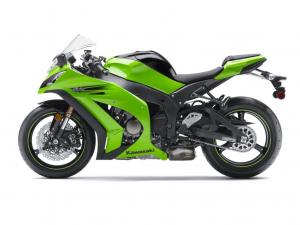
Wheel-speed sensors are a key component of OEM TC systems, but S-KTRC does without an accelerometer (Ducati) or a gyro bank-angle input (BMW). The Kawi system (in development for five years) uses a Mitsubishi ECU to monitor engine speed, throttle position, acceleration rate and comparative wheel speeds to judge the bike’s slip angle, retarding ignition timing if the tires need to be reined back in. Data points are examined an incredible 200 times per second! By doing without accelerometer or bank-angle sensors, S-KTRC has no fixed maps, so the TC is able to adapt to modifications like exhaust systems or engine tweaks.
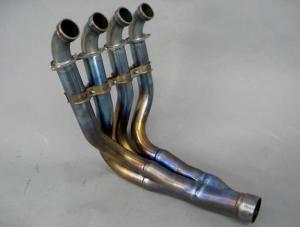
Getting spent fuel out of the engine is the responsibility of a lovely header made from a heat-resistant titanium alloy that offers better durability than standard titanium. Aft of the free-flowing header’s hydroformed collectors is a stainless-steel pre-chamber that includes two catalyzers and an exhaust valve. This under-engine chamber allows a reasonably small stainless-steel muffler on the right side.
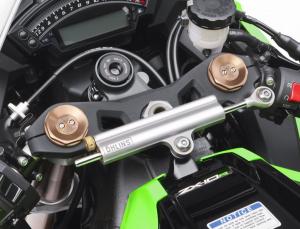
Similarly, the 10R’s swingarm is assembled from three cast aluminum pieces and has a high-quality look. Going against the fashionably long swingarm trend, the Kawasaki’s is said to be shorter than its competitors.
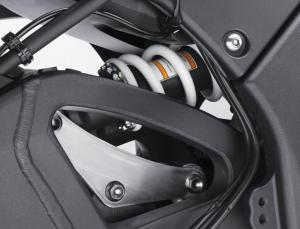
Up front is a 43mm version of Showa’s recent Big Piston Fork, a design we appreciated when testing it on the 2009 ZX-6R. It provides an onset of damping earlier in its stroke to enhance stability during maximum braking, and it weighs less than a conventional cartridge fork. Like any modern literbike, the 10R’s suspension is adjustable for preload, compression and rebound.
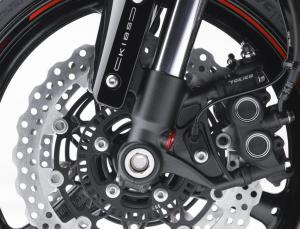
Although many sportbike riders aren’t yet sold on the idea of ABS, KIBS, a “supersport-grade” system, might change some minds. This is allegedly the first ABS-equipped bike in which the fuel-injection ECU communicates with the ABS computer, taking inputs from the bike’s many sensors to make the system operate as seamlessly as possible.
This is not a warmed-over version of the existing 10R – it’s a ground-up redesign with virtually zero carry-over parts. More power and less weight (22 lbs is the target) are naturally part of the package, but less expected is a new traction-control system that is claimed to be the most sophisticated on the market and comes as standard equipment.
The result is a bike said to be a huge 2 seconds quicker around Autopolis than the 2010 edition in back-to-back testing on identical tires on the same day. This indicates it has the potential to turn better lap times than its literbike competitors.
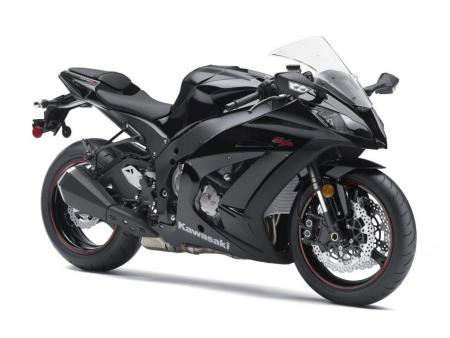 Cap: The 2011 Kawasaki ZX-10R looks especially sinister in its black version. It’s a new favorite among Japanese sportbike design. |
The Ninja’s list of new technology is a lengthy one, so we’ll go through all the detail changes in categories.
S-KTRC (Sport-Kawasaki Traction Control)
With S-KTRC, Kawasaki becomes the first Japanese manufacturer to deliver a race-bred traction-control system to the masses. As an evolution from what was learned on the MotoGP stage, Kawasaki points out that this traction-control system has been developed “to help riders push harder on the track by maximizing acceleration.”
Whereas the KTRC on the Concours 14 is designed primarily for safety, the S-KTRC helps reduce lap times by allowing a certain amount of slip before intervening. As long as “effective traction” is maintained, the TC will still allow power slides and wheelies.

Kawasaki’s sophisticated new S-KTRC traction control is standard equipment on the 2011 ZX-10R.
Kawasaki claims its TC system is so sophisticated that it can predict when traction conditions “are about to become unfavorable,” so it can engage mildly before slippage exceeds the range for optimal traction, minimizing harsh intervention.
Three levels of TC can be dialed in from handlebar switchgear, even while moving, and it can be switched off (while stopped) if you’re especially brave. Your chosen TC setting is stored in memory – like the Ronco Rotisserie, just set it and forget it!
The bottom of the new gauge pack has a 7-section bar-graph display showing the amount of TC intervention. Jeff Herzog, Kawasaki’s senior media relations coordinator and a former racer, said he saw only one bar light up during a full-throttle corner exit over a racetrack’s curb. “You’ll be amazed how often you’ll be able to use full throttle,” he says.
All-New Powerplant
With BMW’s S1000RR blowing away the competition in terms of horsepower, Kawasaki has a lofty target to reach.
Despite what you may have read elsewhere, the new 10R does not have a big-bang firing order, nor horizontal cylinders or variable valve timing. Nevertheless, this is sure to be a potent Japanese literbike engine. The focus was to increase power throughout the midrange to make it more manageable in a variety of conditions.
Kawasaki has reconfigured its inline-Four layout by moving the clutch’s input shaft much higher than previous. This enabled the crankshaft to be raised slightly, further moving the center of mass higher. Contrary to popular belief, a lower CoG isn’t always desirable on a motorcycle, and Kawi claims improved mass centralization and the higher spinning mass provides greater agility.
To squeeze out maximum power, engineers at Team K offset the connecting rod centerline 2mm toward the exhaust side from the bore center. This places less lateral loads on the pistons, reducing power loss due to friction. This process requires labor-intensive torque plates to bore the cylinders accurately.
The crankshaft is now made of a harder material to handle big power. New short-skirt pistons are lighter by nearly 6 grams, offset by stronger con-rods that add about 20 grams but help damp vibration. A single-shaft secondary balancer is said to have its vibration-damping parts simplified for less weight, yet it works well enough to enable the size of the handlebar weights to be reduced, contributing to improved steering response.
Much work was put into the new cylinder head, including 1mm larger titanium intake valves and wider intake ports with a polished finish for smooth flow. Diameters of the titanium exhaust valves remain unchanged, but the exhaust port layout is completely new. New camshafts offer increased lift on both the intake and exhaust sides, and they have changed from cast-iron construction to chromoly steel with a lapping treatment said to offer increased durability and to allow stronger valve springs.
The 10R’s 76.0mm bore and 55.0mm stroke are retained, but the rev limit has been lifted from 13,000 to 13,750 rpm. Peak torque now arrives higher up the rev zone, which is said to eliminate dips earlier in the powerband.
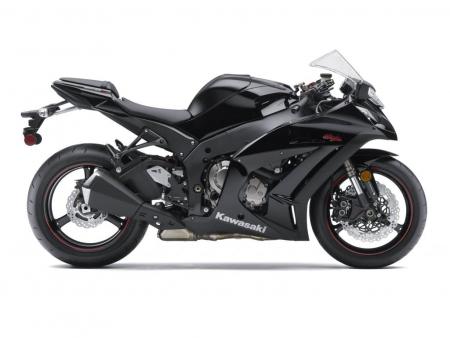 The 2011 ZX-10R. Note the pronounced beak that extends well past the front axle and the thin-spoke wheels that shave nearly 2 lbs of unsprung mass. |
The 6-speed transmission has mildly juggled primary- and final-drive gear ratios that yield closer steps between gears 4 and 6. Racers will appreciate the new cassette design that greatly simplifies trackside gearing changes. A slipper clutch continues, likely still excellent.
The Ninja’s ram-air intake is closer to the bike’s nose for greater ramming effectiveness, with air traveling through the frame’s steering head to a larger airbox and a more efficient air cleaner that pledge better breathing. Larger fuel-injection throttle bodies (from 43mm to 47mm) promise more power and are fitted with sub-throttle valves and dual injectors. A new Idle Speed Control valve is borrowed from Jet Ski technology to automatically adjust idle speed and offer easier starts while helping pass emissions regulations.

This beautiful exhaust header is made of lightweight titanium and is claimed to have nearly the same diameter and length as factory racing headers, so a simple aftermarket slip-on muffler should yield a better-than-typical performance boost.
As is becoming standard on high-performance motorcycles, the new ZX-10R’s power production can be set to various levels that can be selected on the fly. The Low setting delivers 50-60% of maximum. The Middle setting is interesting. It clips power to about 75% of max output, as you might expect, but full power can be temporarily accessed based on throttle position and “usage.” We were shown a chart in which peak power in Middle can climb as high as Full at the upper rev zone, which sounds far more entertaining than the intermediate setting on some other power-mode systems. Unlike the S1000RR, the power setting can be set independently of thetraction control.
Chassis and Frame
The Ninja’s aluminum-beam perimeter frame is a departure from the previous bike’s over-the-engine design, resulting in a more direct line from the steering head to the swingarm pivot that is purported to offer higher levels of feedback and enhanced stability when cornering. Built from cast-aluminum pieces, the nicely finished frame requires less welding and has high rigidity with minimal wall thickness.

An Ohlins steering damper thwarts any instability caused by the Ninja’s sharper steering geometry. Note the pair of damping adjusters atop the Showa BPF fork tubes.
The old ZX-10R (ZX1000F) had the laziest steering geometry in its class, so it was tightened up on the new 10R (ZX1000J/K) to aid the bike’s agility. The steering rake is clipped from 25.5 degrees to a more typical 25.0 degrees, with trail also slightly reduced (3mm) to 107mm. Just as important to the J/K’s new nimbleness, says Kawi, is the engine’s higher center of gravity, explaining that it is now easier to load the front tire for better traction and feedback. The wheelbase stretches 10mm to 56.1 inches, but it can be shortened 16mm if the exhaust’s under-engine pre-chamber and two links of the chain are removed.
Weight has been shaved everywhere, including a lighter battery and ECU, contributing to a 22-lb weight loss to a stated 436.6-lb wet weight. This matches the class lightweight, the Honda CBR1000RR, and makes it 16 lbs lighter than the S1000RR.
Suspension

A new shock arrangement offers shelter from exhaust heat, stabilizing its damping performance.
The rear suspension also incorporates some innovation, as the monoshock is placed nearly horizontal compared to the upright unit on the previous bike. Kawasaki says this back-link design contributes to mass-centralization efforts and somehow provides more feedback. It also frees up room for a larger under-engine pre-muffler chamber, enabling a smaller primary silencer, and also features a piggyback reservoir and dual-range compression-damping adjustability.
The suspension will have an easier job thanks to lightweight gravity-cast wheels. The 3-spoke designs offer immense reductions in unsprung weight: 330 grams less up front; and 490 grams in the rear. That adds up to a huge 1.8 lbs less rotating mass!
Ergonomics
The Ninja’s rider triangle has been tweaked slightly but significantly. The seat height drops 17mm to 32.0 inches, and the handlebars have a reduced downslope for improved comfort. The footpegs are 5mm lower and 2mm forward, and an adjustable mounting allows them to be placed a further 15mm lower for greater legroom.
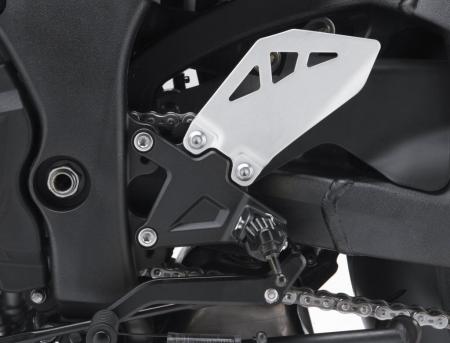 Adjustable footpeg mounts provide 15mm extra legroom in their lower position while still having plenty of ground clearance for street riding. |
Instrumentation
A combination of LCD and LED displays make up what is one of the trickest gauge packs in the industry. At the top is a bar-graph tachometer lit by LEDs, a first on a mass-production bike. The LED illumination is massively brighter than any LCD display, so it is easily visible even in direct sunlight. How bright? The illumination is automatically reduced by 92% at night so it doesn’t blind a rider. In comparison, the brightness of the LDC panel is reduced at night by only 60%. The tach’s LEDs flash when revs reach the adjustable shift point selected by the rider, impossible not to notice.
The LCD panel relays scads of info, including the digital speedometer, dual tripmeters, coolant temperature and clock. Also to be monitored are the power-mode setting, S-KTRC levels, gear position and lap times. An Eco mode appears when you’re riding the 10R like a granny.
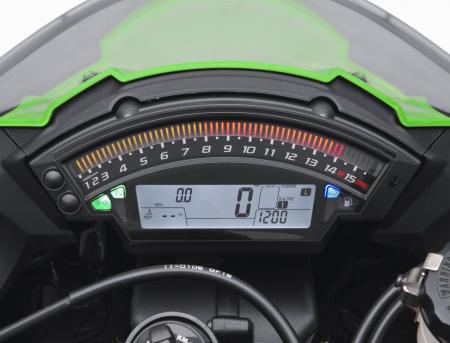 Bright LEDs make up the bar-graph tachometer. A host of other information is transmitted via the LCD cluster below. |
Track riders will appreciate the gauges ability to be switched into Race Mode. This replaces speed with gear position at the center position, flanked by lap times on the left (instead of odometer) and speed on the lower right (instead of the clock).
Appearance
We’ve seen the new ZX-10R in the flesh, and we consider it to be the most attractive 10R ever. The overall shape is chiseled but sleek, with a pointy beak anchored by a centrally located ram-air duct and flanked by sinister-looking line-beam headlights. A nice touch is a 3-bulb LED position lamp at the top of the ram-air duct.
LEDs also provide lighting for the front turnsignals incorporated into the mirrors and the 9-bulb taillight. European ZXs get rear turnsignals faired into the diminutive tailsection, but the DOT forces our bikes to get traditional stalk-mounted clear-lens signals.
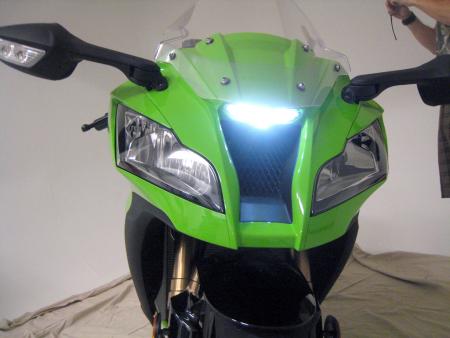 Twin line-beam headlights bookend a voracious ram-air duct, capped off by a slick LED positioning lamp. |
KIBS (Kawasaki Intelligent anti-lock Brake System)

Kawasaki Intelligent anti-lock Brake System is a $1000 option.
Kawi says typical ABS ECUs operate at a 100-millisecond rate, but its unit blazes at just 5 ms. This yields precise control of brake pressure, avoiding the unpleasant sensation of freewheeling when the anti-lock control kicks in, and Kawasaki promises smooth feedback at the lever. A $1000 option, this new Bosch ABS unit is said to be the world’s smallest and lightest, adding only 6 lbs.
Four-piston Tokico radial-mount calipers bite on 310mm petal-shaped discs, whether equipped with ABS or not. A 220mm rear disc is squeezed by a small single-piston caliper.
Summary
The 2011 ZX-10R might be the most important sportbike to be introduced this year. Its all-new design offers a huge number of advancements over the previous 10R (last extensively revamped in 2008). Pre-launch track testing reveals it to be significantly quicker against the earlier generation, which was no slouch, and it also offers important improvements in comfort, instrumentation and curb appeal.
But the talking point most likely to be discussed is the S-KTRC traction control, noteworthy for its alleged sophistication and for being the first Japanese bike to have a performance-grade TC system. Also remarkable is that S-KTRC is standard equipment.
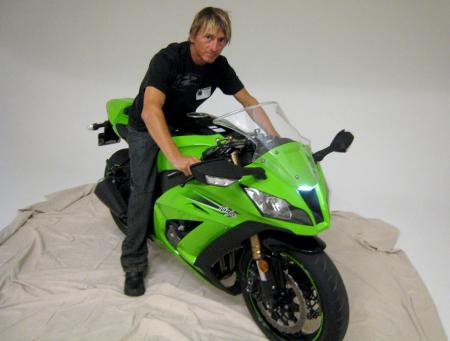 Yep, we already had a chance to try on the 2011 ZX-10R for size. We like the new ergo layout and appreciate footpegs that can be lowered when not mach-ing down the Corskscrew. |
All this freshly hatched technology can be had for $13,799 when the bikes hit dealers by early December. We can’t wait to test it for ourselves to see if it’s ready to take on the S1000RR for our Sportbike of the Year honors.
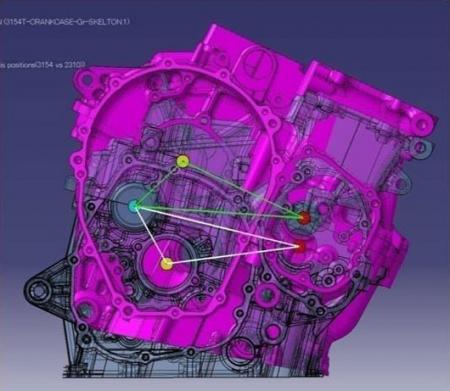
guuuh sooo beautiful
ReplyDeletei dont have that much moneys :(
FFS I WANT THAT ONE
ReplyDeletelol yeah its pretty sick and its cost around of a brand-new toyota yaris
ReplyDeletegoddamn, i want a motorcycle. looks so slick.
ReplyDeletethis is pure speed
ReplyDeleteyou need mad skillz to ride that
ReplyDeleteI just made motor noises while flicking my wrists to shift... I feel awesome
ReplyDeleteI want one now
ReplyDeletelmao it is beast because I've driver very old Kawasaki (1980's model) and you gotta love the sound of it...MRMMM MRAMMMM!
ReplyDeleteKawasaki has been lagging behind the other manufacturers for a few years now. I hope this new Ninja puts them back in contention.
ReplyDelete^ Truly said. Hopefully, it competes with Yamaha, Honda Hero, and Suzuki (all awesome manufacturers).
ReplyDeletei really like that cutaway of the engine
ReplyDeleteThis comment has been removed by the author.
ReplyDeleteI'm more partial to Yamaha though
ReplyDeleteI agree with Joe... I like the cutaway of the engine too
ReplyDeleteI want ONE!!!!!!!!! NAW
ReplyDeleteI'm going to have sex with that bike.
ReplyDeleteThat bike is completely amazing and I want it (duh). Too bad I'm broke! hah
ReplyDeleteWhy would anyone want a car? Kids can walk, shopping can be delivered and pets are outdated. Bike are the future, and damn hot.
ReplyDelete